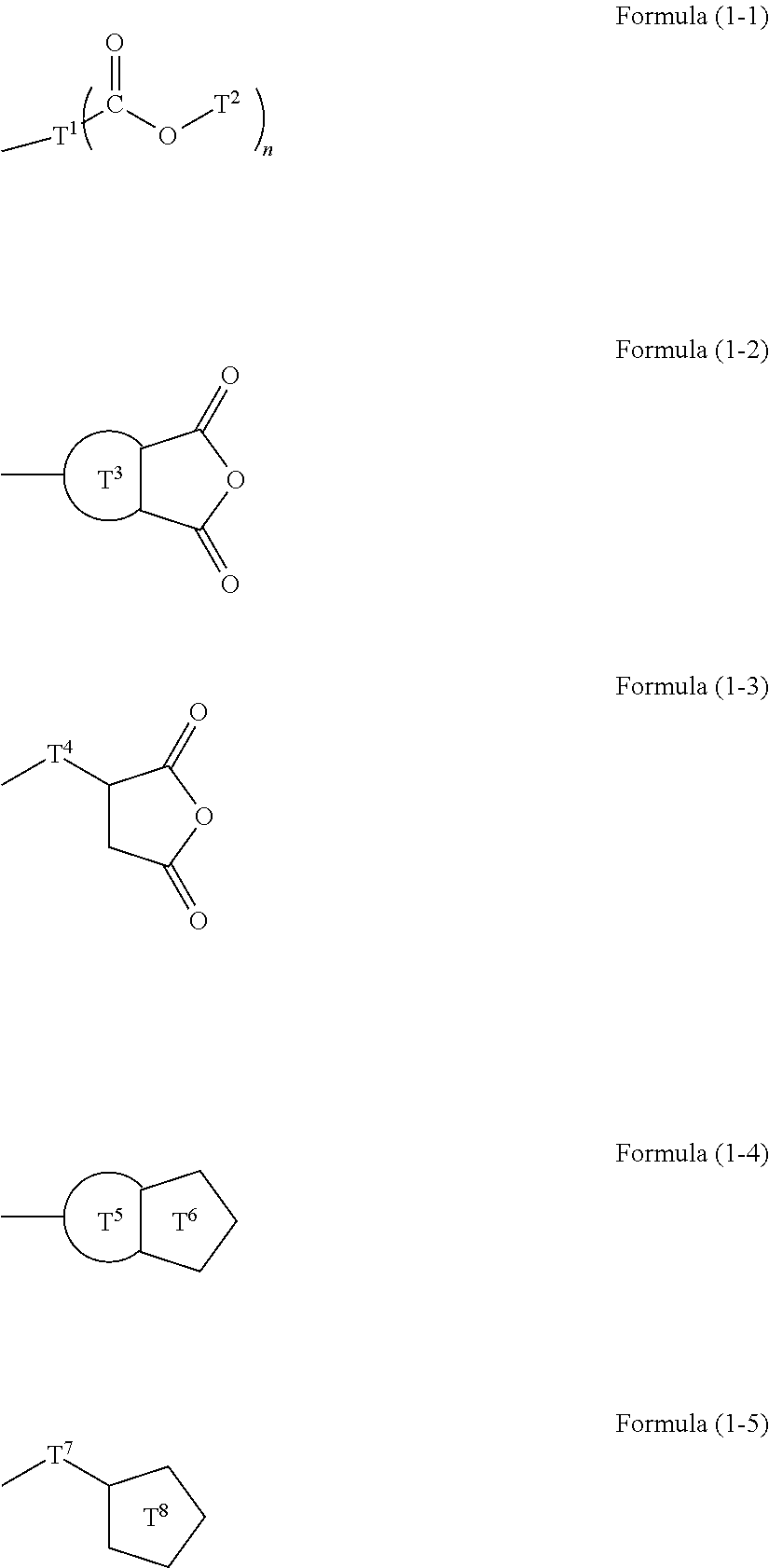Resist underlayer film forming composition containing silicon having ester group
a technology of resisting underlayer film and composition, which is applied in the direction of photomechanical equipment, photosensitive material processing, instruments, etc., can solve the problems of large influence of active ray reflection on a semiconductor substrate, and achieve the effect of satisfying dry etching resistan
- Summary
- Abstract
- Description
- Claims
- Application Information
AI Technical Summary
Benefits of technology
Problems solved by technology
Method used
Image
Examples
synthesis example 1
[0203]15.40 g (75 mol % in all silanes) of tetraethoxysilane, 1.23 g (7 mol % in all silanes) of methyltriethoxysilane, 1.37 g (7 mol % in all silanes) of phenyltrimethoxysilane, 1.72 g (6 mol % in all silanes) of methylsulfonyl methylphenyl trimethoxysilane, 1.62 g (5 mol % in all silanes) of (5-(triethoxysilyl)norbornene-2,3-dicarboxylic anhydride, and 32.00 g of acetone were charged into a 100 mL flask. While the resultant mixture solution was stirred with a magnetic stirrer, 6.66 g of a 0.01 mol / L hydrochloric acid was added dropwise into the mixture solution. After the completion of the addition, the flask was transferred into an oil bath adjusted to 85° C., and under warming-reflux, the reaction was effected for 240 minutes. Then, the reaction solution was cooled down to room temperature and to the reaction solution, 21 g of propylene glycol monomethyl ether acetate was added. From the resultant reaction solution, ethanol as a reaction by-product, water, and hydrochloric acid ...
synthesis example 2
[0204]15.48 g (75 mol % in all silanes) of tetraethoxysilane, 1.24 g (7 mol % in all silanes) of methyltriethoxysilane, 1.37 g (7 mol % in all silanes) of phenyltrimethoxysilane, 1.73 g (6 mol % in all silanes) of methylsulfonyl methylphenyl trimethoxysilane, 1.51 g (5 mol % in all silanes) of 3-(triethoxysilyl)propylsuccinic anhydride, and 31.98 g of acetone were charged into a 100 mL flask. While the resultant mixture solution was stirred with a magnetic stirrer, 6.69 g of a 0.01 mol / L hydrochloric acid was added dropwise into the mixture solution. After the completion of the addition, the flask was transferred into an oil bath adjusted to 85° C., and under warming-reflux, the reaction was effected for 240 minutes. Then, the reaction solution was cooled down to room temperature and to the reaction solution, 21 g of propylene glycol monomethyl ether acetate was added. From the resultant reaction solution, ethanol as a reaction by-product, water, and hydrochloric acid were distilled...
synthesis example 3
[0205]15.44 g (75 mol % in all silanes) of tetraethoxysilane, 1.23 g (7 mol % in all silanes) of methyltriethoxysilane, 1.37 g (7 mol % in all silanes) of phenyltrimethoxysilane, 1.72 g (6 mol % in all silanes) of methylsulfonyl methylphenyl trimethoxysilane, 1.56 g (5 mol % in all silanes) of the compound 1, and 31.99 g of acetone were charged into a 100 mL flask. While the resultant mixture solution was stirred with a magnetic stirrer, 6.68 g of a 0.01 mol / L hydrochloric acid was added dropwise into the mixture solution. After the completion of the addition, the flask was transferred into an oil bath adjusted to 85° C., and under warming-reflux, the reaction was effected for 240 minutes.
[0206]Then, the reaction solution was cooled down to room temperature and to the reaction solution, 21 g of propylene glycol monomethyl ether acetate was added. From the resultant reaction solution, ethanol as a reaction by-product, water, and hydrochloric acid were distilled off under reduced pres...
PUM
| Property | Measurement | Unit |
|---|---|---|
| molar ratio | aaaaa | aaaaa |
| molar ratio | aaaaa | aaaaa |
| molar ratio | aaaaa | aaaaa |
Abstract
Description
Claims
Application Information
 Login to View More
Login to View More - R&D
- Intellectual Property
- Life Sciences
- Materials
- Tech Scout
- Unparalleled Data Quality
- Higher Quality Content
- 60% Fewer Hallucinations
Browse by: Latest US Patents, China's latest patents, Technical Efficacy Thesaurus, Application Domain, Technology Topic, Popular Technical Reports.
© 2025 PatSnap. All rights reserved.Legal|Privacy policy|Modern Slavery Act Transparency Statement|Sitemap|About US| Contact US: help@patsnap.com



